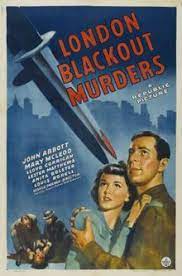
During the London Blitz Mary Tillet (Mary McLeod) moves to London after her home and parents were killed in a bombing raid. She moves into a small apartment that is located over a tobacconist. The owner of the tobacco shop is Jack Rawlings (John Abbott). Rawlings appears to be a nice landlord so Mary does her best to settle in. An old biddy named Mrs. Pringle (Anita Sharp-Bolster) remarks that she would never live in that apartment.
Later that night Rawlings goes to a blackout shelter. Hidden in his pipe is a hypodermic needle. He stabs a man in the back and leaves. After he returns home Mary asks Rawlings about Mrs. Pringle’s comment. Rawlings tells her that the apartment was where one of Jack the Ripper’s victims lived and some people believe the apartment is haunted. He convinces her that there’s nothing wrong with the apartment. When a delayed bomb goes off nearby, pictures fall off the wall and items on a table fall to the floor and break. Mary picks up Rawlings’ pipe and sees the hypo hidden inside. He grabs the pipe from her. Mary is taken aback but says nothing.
The next day at lunch Mary sees the newspaper report about the murder. Mary is now suspicious that her kindly landlord is really murderer. Mary is not the only one who is suspicious. Inspector Harris (Lloyd Corrigan), from Scotland Yard has also become interested in the tobacco seller when he is in the vicinity of another murder. What isn’t known is why these particular people are being singled out, and taken out.
“London Blackout Murders” was released in 1943 and was directed by George Sherman. Written by Curt Siodmak, it is an American mystery thriller and a poverty row film set in England but made in America.
Filmed during WWII the movie shows exactly what life was like during that time. The feel of the movie is quite dark and a little moody. Who the killer is, is not nearly as important as why he kills. The movie takes a bit of a twist that asks the question what is right and what is wrong. The atmosphere of war adds a deeper dimension to the film that highlights the ambiguity of what is ethical and righteous during a time when world events can change our view of national honor vs legal ethics. Can you kill for the right reason?
During WWII there was a man who murdered at least four women during a six day period in London in 1942. The papers called him the “Blackout Killer”, the “Blackout Ripper” and the “Wartime Ripper”. His name was Gordon Fredrick Cummins. He was caught and convicted of murdering Evelyn Oatley. Cummins was sentenced to death and hanged in 1942. Some believe that “London Blackout Murders” was loosely based on the actual 1942 killings but with a political twist. The idea of murders happening in London’s air raid shelters may have been in Siodmak’s mind but nothing else in the film correlates to the 1942 brutal mutilation murders.

